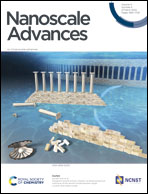Highly stretchable and sensitive strain sensors with ginkgo-like sandwich architectures†
Abstract
The development of a strain sensor that can detect tensile strains exceeding 800% has been challenging. The non-conductive stretchable Eco-flex tape has been widely used in strain sensors due to its high elastic limit. In this work, an Eco-flex-based strain sensor that was conductive until occurrence of fracture was developed. The silver nanoparticles and carbon nanotubes constituted stretchable conductive paths in the Eco-flex matrix. The maximum tensile strain of this sensor was 867%, and the resistance change rate was higher than 104, while the strain resolution was 7.9%. Moreover, the sensor is characterized by segmented logarithmic linearity. This excellent performance was attributed to the ginkgo-like pattern, the patterned strain-coordinating architecture (PSCL), and specific nanocomposites with micro-cracks. The deformation of the architecture and the evolution of the microcracks were studied. In addition, the application of this strain sensor on a wing-shaped aircraft was proposed and its feasibility was demonstrated.



 Please wait while we load your content...
Please wait while we load your content...